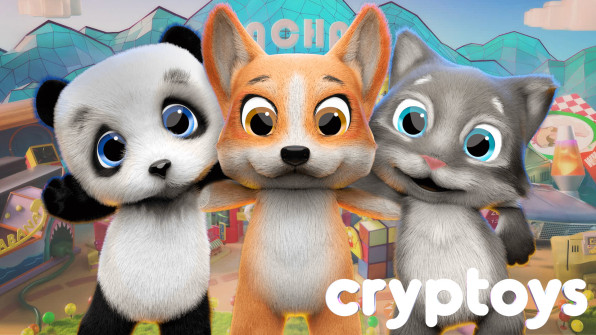[ad_1]
Many adults from millennial to Gen X have fond memories of childhood passed in a bygone era—of halcyon days spent racing tiny metal Hot Wheels cars on precariously constructed loop-de-loops, arranging American Girl dolls at the tea table while a polyvinyl lunch cooks on a Fisher-Price stovetop. But their children will make different memories.
Today’s 12-year-olds might still own Hot Wheels, but instead drive them up simulated mountain ranges found halfway across the world; or American Girls, with which they fight throngs of pixelated jungle creatures in a virtual quest to defeat a final boss.
In this age, that’s possible with the power of imagination—and through a new collaboration between legacy toymaker Mattel and Cryptoys, a platform for playable NFTs.
Through the new partnership, which is being announced later today, some of Mattel’s most beloved intellectual property—which boasts the storied heroes of Hot Wheels, American Girl, Thomas the Tank Engine, Polly Pocket, Barbie, and Masters of the Universe, although it’s unclear which specifically will be part of the partnership—will be transformed into playable avatars on Cryptoys, a blockchain-based “metaverse” developed by OnChain Studios and funded by Andreessen Horowitz and Dapper Labs, which lets NFTs mobilize in an array of phone, tablet, or desktop mini-games. Think of it as the Zynga of Web3, where you have creator privileges to introduce your own custom skins—and eventually your own rules, by coding new games via open-source blockchain infrastructure, which Cryptoys is working to achieve.
To clarify, Cryptoys’ “flavor” of metaverse, as its founder Will Weinraub tells Fast Company, is the casual game ecosystem—the Bejeweled and Doodle Jumps of the world, which together command a market of over 3 billion casual gamers.
“We’re not building the Web3 version of Warcraft,” he says, noting that those sprawling, immersive games take years to engineer, and are often surrounded by tall financial and technological barriers to entry for players. Cryptoys, meanwhile, if given licensing rights for, say, the Bored Ape Yacht Club, could take just months to crank out a mini-game in which you tap the screen to fling disgruntled primates over a Tetris of obstacles (call it “Angry Monkeys”). In another nod to Web 2.0, the games will be launched on browsers to start.
But make no mistake: The company, along with Mattel, is on a mission to discover the “future of toys” and what that looks like in our evolving world. Last June, Mattel became the first toymaker to mint an NFT, and in November it dropped a Hot Wheels collection that sold out within an hour, followed by a joint drop between Barbie and the luxury fashion house Balmain.
“No doubt about it, the playground is expanding,” Mattel’s president, Richard Dickson, told Fast Company. “We want to be at the forefront of that evolution of toys in both the physical and digital worlds . . . our business leads us to wherever the consumer is, and that includes the metaverse and NFTs.”
In other words, rather than buying a $50 action figure to play with in their bedroom, kids might buy a $50 NFT to play as an avatar in a virtual universe.
Planet of the avatars
Despite the Zynga metaphor, Weinraub describes Cryptoys as the Nintendo native of Web3—where the platform is the console and the avatars are the cartridges, each unlocking a unique set of character-specific games.

And these next-generation avatars are far from static. Cryptoys employs an artificial intelligence team that will grow your NFT’s brain over time, imbuing it with learned skills as you interact with it—like a Neopet, with which you can have increasingly sophisticated conversations. In game-world, your NFT could graduate from a combat rookie to a super-soldier. Perhaps someday, there could be a bustling secondary marketplace for NFTs that have been juiced up to god-tier.
But for now, Cryptoys is focused on the launch, which is coming late this summer, followed by several other licensing partnerships. It will also drop NFTs for a handful of original characters—a cat, a corgi, and a panda—which its website depicts in scenarios requiring a lab coat and glasses, and pair of rollerblades, an aviator helmet, and a karate gi.
The nature of the games designed for Mattel’s properties has yet to be revealed, but it’s suggested they will be similar to classic web games: arcade-style, carnival-style, puzzles, and infinity-runners. And despite Mattel’s toddler-friendly reputation, Cryptoys will start out restricted to 18+—given the logistics of owning an NFT, opening a digital wallet, et cetera—but will eventually offer parent-controlled wallets for minors.
With the rash of “profile-pic” NFTs being sold in marketplaces since early 2021, playable metaverse characters seem like an obvious next step—but still, it’s one that hasn’t come easy, with companies just beginning to experiment in the last half-year.
“Interactive NFTs have a whole new level of complexity—you’re building on gaming engines like Unity or Unreal, you need 3D modeling artists, texture artists, you need to conceptualize the experiences around these characters, since they can’t just stand there and do nothing,” says Weinraub. “There are a lot of layers to the process.”
And progress is further stymied by the fact that the serious gamer community has staunchly refused to embrace NFTs, with crypto forays from major studios like Electronic Arts and Ubisoft meeting fierce backlash from fans.
But now, Weinraub predicts, a new boom is coming, which could lift crypto out of its current bear market and into its next bull run. “In the next year, I believe a lot of the projects that were funded during the first bull run, two years ago, will start to see the light of day, which will kickstart a wave of entertainment and utility around NFTs,” he says. “It just takes a while for that to be built.”
[ad_2]
Source link

